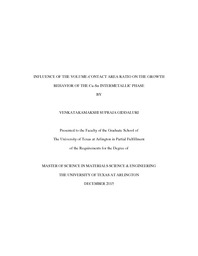
ATTENTION: The works hosted here are being migrated to a new repository that will consolidate resources, improve discoverability, and better show UTA's research impact on the global community. We will update authors as the migration progresses. Please see MavMatrix for more information.
Show simple item record
| dc.contributor.advisor | Kim, Choong-Un | |
| dc.creator | Giddaluri, Venkatakamakshi Supraja | |
| dc.date.accessioned | 2016-01-26T23:13:26Z | |
| dc.date.available | 2016-01-26T23:13:26Z | |
| dc.date.created | 2015-12 | |
| dc.date.issued | 2015-12-21 | |
| dc.date.submitted | December 2015 | |
| dc.identifier.uri | http://hdl.handle.net/10106/25447 | |
| dc.description.abstract | Solder Joints play a very important role in electronic packaging industry by serving as mechanical support and provides integrity to the device. The increasing demand for high performance, environmental and economic feasibility and miniaturization led to the development of high density interconnects. With the reduction in the size/stand off height of the solder is the reliability issues in the surface mount assemblies and packaging structures under various rigorous environments.
One of the most important impact factors that affect the solder joint reliability is the growth rate IMC formed between the solder and substrate. IMC formation is required to ensure good bonding and connectivity of the device in packaging. However excess IMC growth rate is detrimental to the device from mechanical aspects due to its brittle nature. With the evolution of concise and compact solder joint size compatible with the sophisticated packaging trends, the impact of IMC layer thickness on solder joint reliability becomes even more critical with the introduction of lead free solders. Thus there is a need to study effect the IMC growth rate behavior with the solder joint size/standoff height.
In this present study, two solder joints of different standoff heights and same composition (pure Sn solder) are used subjected to reflow process at 270°C for 1-7 min to study solid liquid interfacial reaction on joint size and the same experiment is repeated with SAC alloy of composition (96.5% Sn, 3.0% Ag, 0.5% Cu) to investigate the effect of joint size and initial copper concentration on IMC growth rate. The IMC thickness of the Sn 15µm solder joint at 1 min and 7 min is found to be 1.52µm and 2.86µm respectively while that of Sn 150µm solder joint is 1.31µm and 3.16 µm. The thickness is high in low standoff height sample at the early stage of reaction with decrease in IMC growth rate as the time of reflow increases. In case of 25µm SAC alloy solder joint the IMC thickness from 1 and 7 min is found to be 2.1µm and 3.5µm while that of 250µm SAC alloy solder joint its 1.43µm and3.235µm. Similar trend is observed but the IMC thickness is more in SAC alloy compared to Pure Sn due to initial Cu concentration effect. The CGC model is applied for growth kinetics of IMC formation and is in well agreement with the experimental results. It is found that the low stand off height solder joint follow t1/3 law and high stand off height solder joint deviates from the t1/3 due to unsaturation.
The pure Sn solder of two different standoff height is also subjected to isothermal aging tests at 120°C for 0-600 hours to investigate the effect of IMC growth rate on solder joint size in solid state diffusion. It has been found that low solder joint height is having high growth rate compared to high stand off height joint and it is found to obey parabolic law and follow reaction diffusion control mechanism. | |
| dc.format.mimetype | application/pdf | |
| dc.language.iso | en_US | |
| dc.subject | Reflow time | |
| dc.subject | Stand off height | |
| dc.subject | CGC model | |
| dc.title | Influence of the Volume-Contact Area Ration on the Growth Behavior of the Cu-Sn Intermetallic Phase | |
| dc.type | Thesis | |
| dc.date.updated | 2016-01-26T23:13:57Z | |
| thesis.degree.department | Materials Science and Engineering | |
| thesis.degree.grantor | The University of Texas at Arlington | |
| thesis.degree.level | Masters | |
| thesis.degree.name | Master of Engineering in Materials Science and Engineering | |
| dc.type.material | text | |
| dc.creator.orcid | 0000-0002-6913-9727 | |
Files in this item
- Name:
- GIDDALURI-THESIS-2015.pdf
- Size:
- 1.269Mb
- Format:
- PDF
This item appears in the following Collection(s)
Show simple item record


